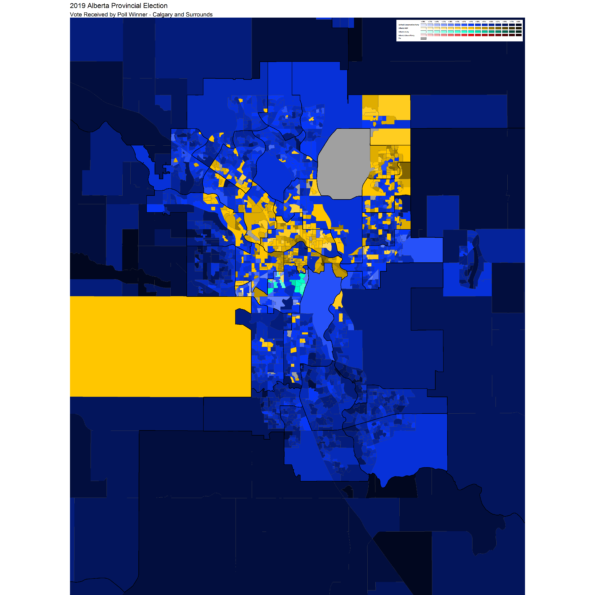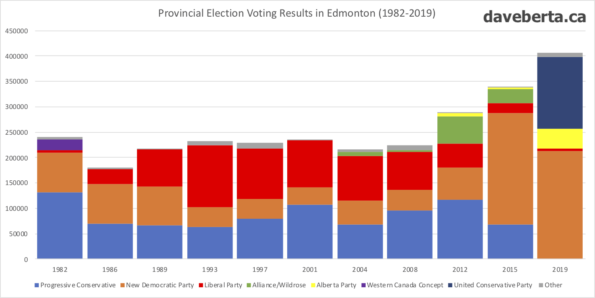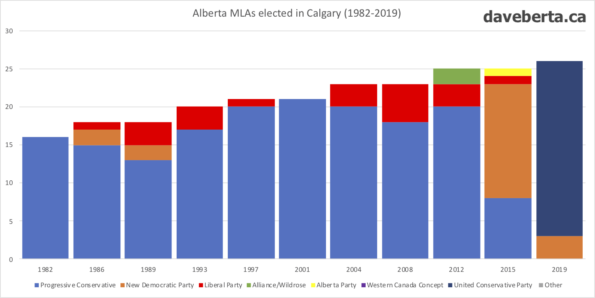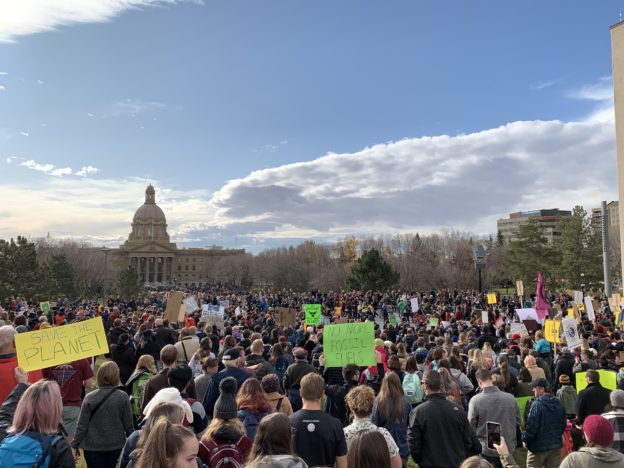The Battle of Alberta is a term usually reserved for competitions on the hockey rink or football field, but the rivalry between Calgary and Edmonton probably predates our professional sports clubs. While the animosity felt by some sports fans might not be felt the same way among voters, the politics and political divides between the two cities have helped defined Alberta politics since the province was created in 1905. From the decision of where to place Alberta’s capital city to where the province’s first university should be located, the roles played by the two major cities have been a periodic point of tension in provincial politics.
There are many reasons that explain the current political differences between the two cities, from the backgrounds of the settlers who founded the cities to the most recent round of economic convulsions.
As a friend of mine once put it, Calgary is where business decisions get made, Edmonton is where government decisions get made.
Calgary sees itself as the business capital, heavily influenced by connections to the American oil industry in Texas and the home of the braintrust of the federal Conservative movement. Edmonton is the government capital, heavily influenced by a combination of public servants and University employees as well as a base of blue-collar and trades workers with connections to Fort McMurray and northern Alberta.

These are obviously big generalizations that don’t reflect the diversity and complexity of the two cities but it does help explain some of the political differences between the two municipalities.
While I think the political differences between two two cities can sometimes be overstated, a troubling political narrative that has developed over the past six years has been that because Calgary is perceived to have felt the brunt of the economic fallout caused by the drop in the international price of oil, it is now Edmonton’s turn to feel the economic pain (translation: public sector wage rollbacks and job cuts).
There is an old saying in Alberta politics that a party has to win most of the seats in two of the three political regions of the province in order to form government – Calgary, Edmonton or rural Alberta. The “rural Alberta” in this calculation includes the small and medium size cities, which, with the exception of Lethbridge, have in the past four decades mostly voted in sync with the rest of rural Alberta – conservative.
But the calculation is generally correct. With a combined 46 seats in the Legislature, the two large cities represent the majority of Alberta voters (I hope to write more about voting patterns in “rural Alberta” in a future article).
This year marks one year since the United Conservative Party won the 2019 election and five years since the New Democratic Party won the 2015 election, undeniably two of the most important elections in Alberta’s recent political history. The two votes marked the first changes in government in Alberta since 1971, and both highlighted the political differences between Calgary and Edmonton.
The Progressive Conservatives had dominated Calgary since 1971 but in 2015 a combination of a surge of votes and the first-past-the-post electoral system allowed the NDP to elect 15 MLAs with 34 percent of the vote. The PCs earned 31 percent and the Wildrose placed third with 23 percent in Alberta’s largest city.

The 2015 election marked the first time since 1989 that the NDP had elected an MLA in Calgary and the first time since 1967 that a party other than the PCs won a majority of seats in the city.
While many prominent conservative pundits and politicians claimed the NDP breakthrough in Calgary, and much of the rest of Alberta, was a result of a vote-split on the political right, a closer look at that election would support the argument that the vote split was actually between the NDP and Wildrose among voters unhappy with the 43-year governing PC Party dynasty.
Edmonton has earned the nickname Redmonton for its reputation for electing more Liberals and NDP MLAs than anywhere else in the province. But despite the nickname, the capital city is historically more electorally competitive than it is an opposition bastion. Voters in the capital city have swung between parties more frequently than any other region in Alberta, making it one of the few consistently competitive areas of the province.
Led by Edmonton-Strathcona MLA Rachel Notley, the NDP swept the city in 2015, earning 65 percent of the total vote and winning every seat. The PCs earned 20 percent and the Wildrose finished with 8 percent in the capital city.
As one local PC Party campaign manager described to me after the 2015 election, their candidate faced “a giant impenetrable wall of orange.”

Four years later in 2019, the NDP maintained its vote share in Calgary but were only able to elect three MLAs as the UCP succeeded in consolidating the large base of PC and Wildrose voters, though a number of UCP candidates earned below the combined totals from the previous election. The NDP earned 34 percent of the vote and the UCP, led by Calgary-Lougheed MLA Jason Kenney, amassed 53 percent and elected 23 MLAs.
The seats won by Calgary NDP MLAs in the 2019 election have a tradition of electing non-conservative MLAs. Calgary-Buffalo and Calgary-Mountain View elected Liberals and NDP MLAs in the 1980s and 1990s, and Calgary-McCall swung to the Liberals in the 2000s.
Although the NDP lost all but one of the suburban surrounding the city, the party maintained its dominance in Edmonton in 2019, winning 53 percent of the vote and holding all but one seat. The UCP elected 1 MLA and earned 35 percent of the vote in the capital city.

The only viable third party in the 2019 election, the Alberta Party, earned 10 percent of the vote in both cities but failed to elect any MLAs. Party leader Stephen Mandel was unsuccessful in his bid for election in Edmonton-McClung and its two Calgary incumbents were defeated.
Past elections in the two cities
The results of these two elections, and how they have shaped Alberta politics in the most recent two election prompted me to take a broader look at voting results in Calgary and Edmonton over the past four decades.

1986: The departure of Peter Lougheed as Premier of Alberta in 1985 clearly had a big impact on Alberta politics, as the economic recession that followed allowed NDP led by Edmonton-Norwood MLA Ray Martin breakthrough in the capital city in the 1986 election.
Calgary remained a PC Party stronghold following Lougheed’s departure, with the NDP and Liberals electing a handful of MLAs between 1986 and 1997, and 2004 and 2012.
The election of Liberal Sheldon Chumir in Calgary-Buffalo in 1986 marked the beginning of a long-line of non-conservative MLAs representing that district. Non-conservative candidates would win in Calgary-Buffalo in nine of the next eleven elections (the district is currently represented by NDP MLA Joe Ceci).
Edmonton became the competitive hotbed of Alberta politics and a deep rivalry developed between Liberal Party and NDP partisans in the capital city.
The competition between the Liberals and NDP in Edmonton during this period generated much discussion around a “unite the left” movement to defeat the PCs, though this perennial debate largely became mute when the NDP formed government in 2015.

1993: In 1993, Premier Ralph Klein further consolidated his party’s electoral grip on Calgary while the Liberals led by former mayor Laurence Decore executed a clean sweep of the capital city. The Liberals were the beneficiaries of a collapsing NDP vote and also a burgeoning group of Reform Party voters wanting change on the provincial and federal levels.
The Liberals would again dominate Edmonton in the 1997 and 2004 elections, though the party began to resemble a group of independents more than the cohesive political organization created by Decore.
Competition between Decore’s Liberals and former Calgary mayor Klein’s PCs led to obvious descriptions of provincial politics as the battle of Alberta.
2001: The 2001 election marked a turn back toward the PC Party in Edmonton, which would then lose most of its seats when the Liberals and NDP rebounded in 2004 before regaining ground in the city in 2008 and 2012. This period marked the beginning of a decline of the Liberal Party in Edmonton after almost two decades as the official opposition party.
The 2001 election also marked the first time since 1982 that the PCs won every seat in Calgary.
2004: The 2004 election marked a breakthrough for the opposition Liberals in Calgary where the party elected three MLAs, the most since 1993. The Liberals would expand its voter base in Calgary and elect four MLAs in 2008 as the party’s fortunes in Edmonton sharply declined after it regained much of its seats in the 2004 election.
2012: The 2012 election marked a significant shift in the political environment in Alberta with the two large cities coalescing behind the PC Party. The opposition Wildrose Party swept much of rural Alberta, forming the first rural based official opposition party since the Social Credit Party in the 1970s. This trend would continue in the 2015 election as the Wildrose Party regained most of its seats following the 2014 floor-crossings.
(Note: Thank you to Shane Smith for sharing the poll level election maps. You can follow Shane on Twitter at @Smith80D).


4 replies on “The Battle of Alberta Politics: How voters in Calgary and Edmonton can sometimes be so different”
One thing the raw vote charts make clear is that raw turnout increased in 2015, and then again quite a bit more in 2019.
Was that an artefact of a growing population — or did it reflect the fact that politics was finally more competitive in Alberta on a provincial level, and so riding-level contests were not only more competitive, but the outcomes more meaningful in terms of who would actually win the election. I’ve often thought – looking from a distance – that turnout was historically so low in Alberta because the outcome of an election was rarely in doubt. Was that perhaps what made the turnout difference in the last two elections?
Or did the surprise outcome of the 2015 election lead to a higher turnout in 2019 attempting to restore the earlier status quo?
Interested in your thoughts.
Hi Alice – Great question. Voter turnout has increased in the three elections since 2012, arguably the most competitive in recent history. I do tend to agree that turnout in Alberta has been traditionally lower because of the lack of competitiveness.
Turnout seemed to stagnate starting in the mid-1980s, with the exception of an upswing in turnout in 1993, and dipped to a 40.59% low in 2008. The turnout in some ridings, like Fort McMurray-Wood Buffalo, was 19.84% in 2008. Really low.
Albertans sure are suckers for punishment, aren’t they? The Alberta PCs turned foul in the mid 1980s, and never did anything other than leave our important services in a shambles, and be partakers of the worst kinds of cost laden shenanigans, since that time. Where did that take Alberta for when the inevitable happened, when oil prices came tumbling down? Nowhere. The cupboards, the pantry and the cellar have nothing left in them. What do Albertans do? They foolishly lay blame on the NDP, or the federal Liberals. Next, Albertans decide another Conservative government is needed to fix things up. In come the UCP, who are covered in controversies, and who illegitimately rose to power, (there is too much proof to deny the last provincial election in Alberta wasn’t rigged), and all they are capable of doing is more cost laden shenanigans. If you are on AISH, earning a measly income, via minimum wage, a doctor, a nurse, or some other medical practitioner, a student, in any grade, or in a post secondary institution, a teacher, or a senior citizen, the UCP doesn’t hold you in high regard. Albertans sure are suckers for punishment alright. Insanity is doing the same thing over and expecting a different result. Anyone who doesn’t vote for the crooked Cons in Alberta gets ostracized. Why should they be? Albertans that support these Cons need to take another look at how things are under their rule. They aren’t helping Alberta in any way, shape, or form.
I have never been fond of stereotypes and particularly dislike the ones applied to our major Alberta cities. As if no one in Edmonton works in the private sector, or no one in Calgary works for the government. I am fairly sure there are public schools, hospitals and municipal employees in Calgary and some banks even have their headquarters in Edmonton. I think at one time there was an attempt many years ago by a provincial government, when our cities were much smaller, to specialize that led to this, but as both cities grow and become more diverse, I think this becomes less relevant and accurate.
However, past voting does show differences based both on history and perception. Although, of course it is not surprising that a former mayor of Calgary might do better there and a former mayor of Edmonton might do better in Edmonton, so it is not just or only political ideology that is a factor.
I think the million dollar question is will this historical pattern hold or will it change somewhat in upcoming years. Also the historical idea that a party needs to win two of the three regions in Alberta (Edmonton, Calgary and rural Alberta), may also change somewhat in the future, with the two biggest cities growing quite a bit faster than rural Alberta.